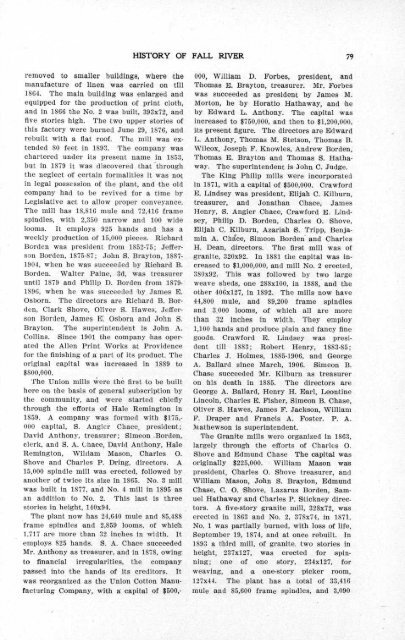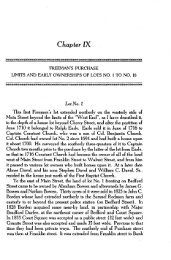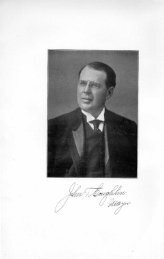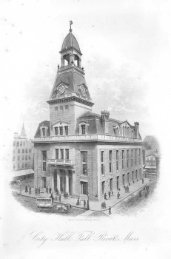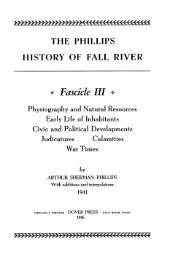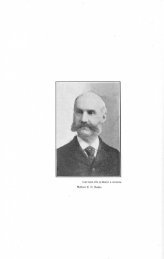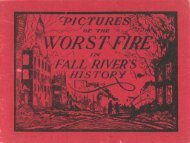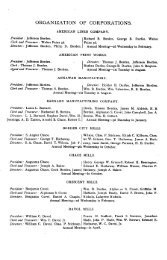Fall Rivers' Industries
Fall Rivers' Industries
Fall Rivers' Industries
You also want an ePaper? Increase the reach of your titles
YUMPU automatically turns print PDFs into web optimized ePapers that Google loves.
emoved to smaller buildings, where th e<br />
manufacture of linen was carried on til l<br />
1864. The main building was enlarged an d<br />
equipped for the production of print cloth ,<br />
and in 1866 the No. 2 was built, 393x72, and<br />
five stories high. The two upper stories of<br />
this factory were burned June 29, 1876, an d<br />
rebuilt with a flat roof. The mill was extended<br />
80 feet in 1893 . The company wa s<br />
chartered under its present name in 1853 ,<br />
but in 1879 it was discovered that throug h<br />
the neglect of certain formalities it was no t<br />
in legal possession of the plant, and the ol d<br />
company had to be revived for a time b y<br />
Legislative act to allow proper conveyance .<br />
The mill has 18,816 mule and 72,416 fram e<br />
spindles, with 2,350 narrow and 100 wid e<br />
looms. It employs 925 hands and has a<br />
weekly production of 15,000 pieces. Richar d<br />
Borden was president from 1852-75 ; Jefferson<br />
Borden, 1875-87 ; John S. Brayton, 1887 -<br />
1904, when he was succeeded by Richard B .<br />
Borden. Walter Paine, 3d, was treasurer<br />
until 1879 and Philip D. Borden from 1879 -<br />
1896, when he was succeeded by James E .<br />
Osborn. The directors are Richard B . Bor -<br />
den, Clark Shove, Oliver S . Hawes, Jefferson<br />
Borden, James E. Osborn and John S .<br />
Brayton. The superintendent is John A .<br />
Collins. Since 1901 the company has operated<br />
the Allen Print Works at Providence<br />
for the finishing of a part of its product. Th e<br />
original capital was increased in 1889 t o<br />
$800,000 .<br />
The Union mills were the first to be buil t<br />
here on the basis of general subscription b y<br />
the community, and were started chiefl y<br />
through the efforts of Hale Remington i n<br />
1859 . A company was formed with $175,-<br />
000 capital, S. Angier Chace , president ;<br />
David Anthony, treasurer ; Simeon Borden ,<br />
clerk, and S . A. Chace, David Anthony, Hal e<br />
Remington, William Mason, Charles O .<br />
Shove and Charles P . Dring, directors . A<br />
15,000 spindle mill was erected, followed by<br />
another of twice its size in 1865 . No . 3 mil l<br />
was built in 1877, and No . 4 mill in 1895 a s<br />
an addition to No. 2. This last is thre e<br />
stories in height, 140x94 .<br />
The plant now has 24,640 mule and 85,48 8<br />
frame spindles and 2,859 looms, of whic h<br />
1,717 are more than 32 inches in width. I t<br />
employs 825 hands. S. A. Chace succeeded<br />
Mr. Anthony as treasurer, and in 1878, owin g<br />
to financial irregularities, the compan y<br />
passed into the hands of its creditors. It<br />
was reorganized as the Union Cotton Manu-<br />
facturing Company, with a capital of $500, -<br />
HISTORY OF FALL RIVER 79<br />
000, William D. Forbes, president, an d<br />
Thomas E. Brayton, treasurer. Mr. Forbe s<br />
was succeeded as president by James M .<br />
Morton, he by Horatio Hathaway, and he<br />
by Edward L. Anthony. The capital wa s<br />
increased to $750,000, and then to $1,200,000 ,<br />
its present figure. The directors are Edwar d<br />
L. Anthony, Thomas M. Stetson, Thomas B .<br />
Wilcox, Joseph F. Knowles, Andrew Borden ,<br />
Thomas E. Brayton and Thomas S. Hathaway.<br />
The superintendent is John C . Judge .<br />
The King Philip mills were incorporate d<br />
in 1871, with a capital of $500,000 . Crawfor<br />
. Lindsey was president, Elijah C . Kilburn d E ,<br />
treasurer, and Jonathan Chace, Jame s<br />
Henry, S . Angier Chace, Crawford E, Lindsey,<br />
Philip D. Borden, Charles O. Shove ,<br />
Elijah C. Kilburn, Azariah S. Tripp, Benjamin<br />
A. Chace, Simeon Borden and Charle s<br />
H. Dean, directors. The first mill was o f<br />
granite, 320x92 . In 1S81 the capital was increased<br />
to $1,000,000, and mill No . 2 erected ,<br />
380x92. This was followed by two larg e<br />
weave sheds, one 288x100, in 1888, and th e<br />
other 406x127, in 1892. The mills now hav e<br />
44,800 mule, and 89,200 frame spindles<br />
and 3,000 looms, of which all are mor e<br />
than 32 inches in width. They emplo y<br />
1,100 hands and produce plain and fancy fin e<br />
goods. Crawford E. Lindsey was president<br />
till 1883 ; Robert Henry, 1883-85 ;<br />
Charles J. Holmes, 1885-1906, and George<br />
A. Ballard since March, 1906 . Simeon B.<br />
Chase succeeded Mr. Kilburn as treasurer<br />
on his death in 1885 . The directors ar e<br />
George A. Ballard, Henry H . Earl, Leontin e<br />
Lincoln, Charles E. Fisher, Simeon B. Chase ,<br />
Oliver S. Hawes, James F. Jackson, Willia<br />
. Draper and Francis A . Foster. P. A m F .<br />
Mathewson is superintendent .<br />
The Granite mills were organized in 1863 ,<br />
largely through the efforts of Charles O .<br />
Shove and Edmund Chase The capital wa s<br />
originally $225,000 . William Mason was<br />
president , Charles O. Shove treasurer, an d<br />
William Mason, John S . Brayton, Edmun d<br />
Chase, C. O. Shove, Lazarus Borden, Samuel<br />
Hathaway and Charles P. Stickney directors.<br />
A five-story granite mill, 328x72, wa s<br />
erected in 1863 and No . 2, 378x74, in 1871 ,<br />
No. 1 was partially burned, with loss of life ,<br />
September 19, 1874, and at once rebuilt. I n<br />
1893 a third mill, of granite two stories i n<br />
height, 237x127, was erecte d<br />
for spinning; one of one story, 234x127, fo r<br />
weaving, and a one-story picker room ,<br />
127x44. The plant has a total of 33,41 6<br />
mule and 85,600 frame spindles, and 3,090


